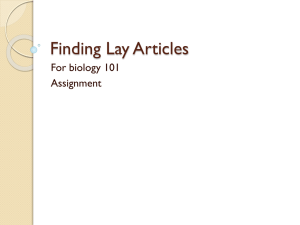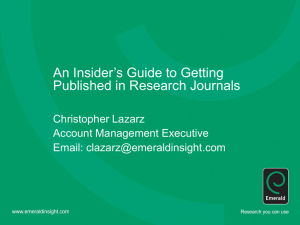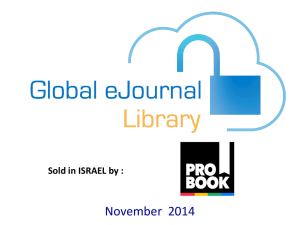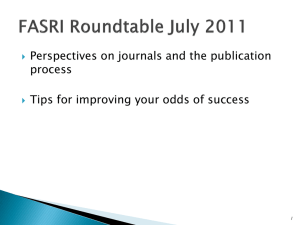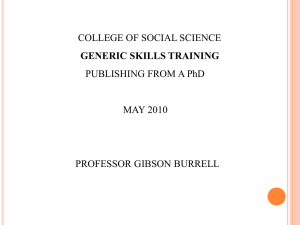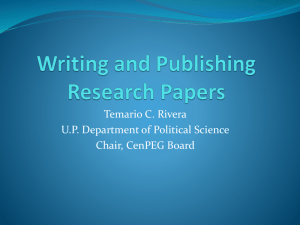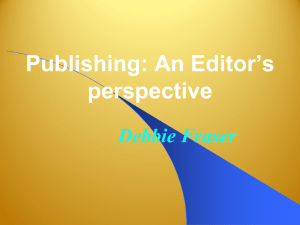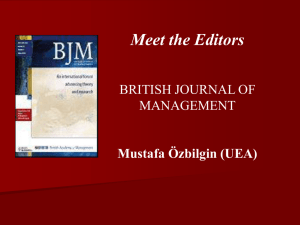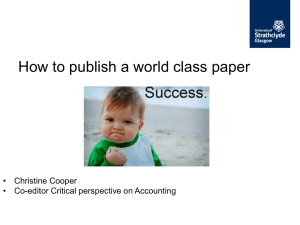How to publish in Entrepreneurship journals
advertisement
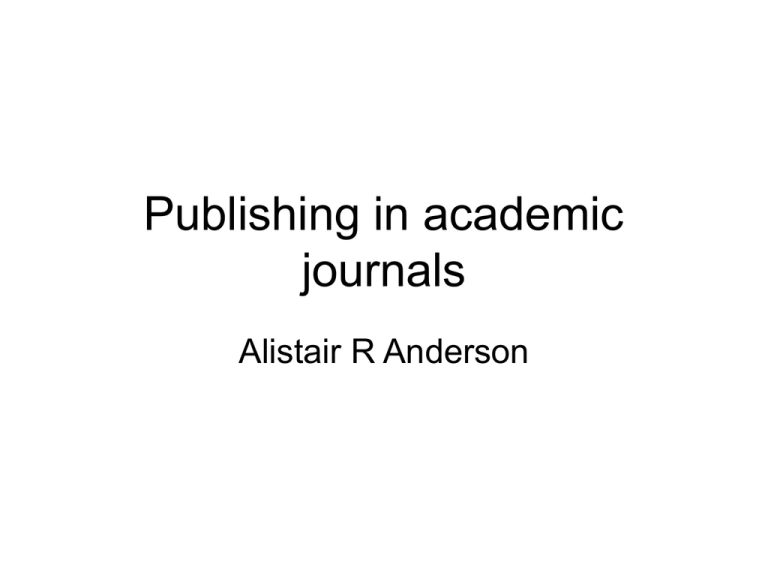
Publishing in academic journals Alistair R Anderson My experience of publishing • First – no claims for any particular expertise • However been fortunate, now have some 80+ journal articles published in a range of journals (from just ok to very good; but almost all in business journals) but h23 • I have also had a substantial number of rejections and only two papers ever accepted without revisions • ( I have even had a reject from my own journal!) • Editorial experience– editor of Entrepreneurship and Regional Development – Editorial board member of several journals – Ad hoc reviewer for many journals So considerable experience of the publishing process Plan for our session • Why publish? – Discussion about reasons why and why not • The publication process – How the system operates • The publishing process – Is there any one “best” way to do it? Why publish? I see two types of good reasons for publishing ‘Personal’ and ‘Institutional’ - Good publications build your reputation - Obviously improves job and promotion prospects - Opportunity to put your efforts into public domain - But also opens many doors - Invitations to do interesting things - Collaborative projects - Funding opportunities This is simply because people get to know who you are, and what you do, by reading your work Paula called this your identity ‘Institutional’ reasons to publish • Your institution’s reputation is enhanced – Attracts better students – Improves standing in academic community • Funding can be attracted • Enhances teaching, and of course • Academic duty to make new knowledge known! So not just PhD but your career prospects Why some people don’t publish • Benefits are often indirect and long term – (Interestingly some US and Canadian universities pay directly for publications) • It isn’t easy and takes a lot of effort • It takes a lot of time • Sometimes, even with effort and time, it doesn’t work • Many people are frightened of “failure” and don’t understand that a rejection is only part of the process – I will have much more to say about this point! First thoughts We look at a paper in a journal and think • Wow that’s good, it’s a polished, thoughtful and well presented piece of work or • Gosh how did that get in there? It’s poorly written and seems trivial and doesn’t seem to say very much that’s significant! We “forget” all that has gone before the publication So thinking about the process may help to understand why some good stuff doesn’t get published and some poor stuff does The publishing process 1. First write an INTERESTING paper (!!) 2. Send it to a journal editor 3. S/he looks at it and decides if it’s worth reviewing (sometimes R&R) 4. One, two or three reviewers read and comment and propose 1. Reject 2. Revise and resubmit 3. Accept The publishing process 4. The editor collects and “collates” the reviews 5. Decides on next stage and advises authors 6. You, as author, then decide what to do - Stage 2 The publishing process Stage 2 You have been advised - Reject Most journal have a high rejection rate, the best reject over 90% of submissions • Organizational Studies received over 390 submissions last year and rejected 94% • My journal, over the last 6 months had a 95% reject rate, with about 55% desk rejected • However, one less prestigious journal I know eventually accepted some 45% • But, some journals probably have a 90% acceptance rate at certain times- but….. Actions- do not take it personally It is the article that has been rejected not you • So need to change target journal and/or improve/alter paper or • Aim for less prestigious publication? • Don’t just forget about it- think through the options • I know of one paper rejected but accepted with no changes for top ranked journal ( so editor’s tastes and requirements vary!) Rejection in context On the basis of a 90+ % rejection rate Crudely put, you need to submit 10 paper to get one accepted! And have 9 rejected!!! So- reject is the norm, acceptance is the exception Types of papers and types of journals Rejection is part of the process • All authors, no matter how famous have rejections! • Even if you get a straight reject, the editor should tell you why – Not suited for journal – (style or topic area) – TARGET TARGET TARGET – Insufficiently theoretical/practical – Brief outline of major “faults” of paper Remember it is the article that is rejected not YOU Rejection is part of the process Often you get a rejection after review -unless you have targeted the wrong journal So you now have at least two reviews and the editor’s comments The reviewers will (usually) explain, in detail, why they rejected the paper So you have now the basis for improving or changing the paper and submitting elsewhere Rejection is part of the process Remember that editors have a difficult job Conflicting requirementsAll want high quality publications but All have to fill the journal They may need to try to keep both authors and reviewers sweet! They may have a lot, or few, publications in the pipeline So its the paper, and in this specific context, that has been rejected- not you, your methods or even your topic Rejection is part of the process Remember that editors have a difficult job Conflicting requirementsAll want high quality publications but All have to fill the journal They may need to try to keep both authors and reviewers sweet! They may have a lot, or few, publications in the pipeline So its the paper, and in this specific context, that has been rejected- not you, your methods or even your topic Revise and resubmit • This is good news, but does not mean any obligation to publish You will have been given a chance to rework the paper along guidelines to improve the chance of publication Some editors will advise you about chances of publication I’d guess that about 30% are accepted for highly ranked journals and About 70% for less well known journals Revise and resubmit • Read the editor’s and reviewers’ comments briefly • Put the paper aside for a week. You may feel that you hate them for “not understanding your work”; “not reading it properly” or simply being “ignorant” • But they are the gatekeepers and should know the job! • Some journals,e.g.JMS, never accept outright! • So now read what they have said very carefully! Revise and resubmit • The editor should have “reviewed” the reviews and provided you with a synopsis of what needs to be done • The referees should have explained what they liked, what they didn’t like and explained why. • A good review will also make some clear suggestions about how the paper can be improved Revise and resubmit However, sometimes they don’t do their job very well (but the very best journals always do) - If the editor doesn’t give you “a steer” - Use the referee’s comments as a guide - If the referees give conflicting opinions - Select the points you like and work on these BUT prepare a convincing explanation of why and why not - Get to work! ( some journal have a tight time limit) - Some journals may have several cycles of r & r So be prepared for that Revise and resubmit When you are satisfied that you have managed to address most points raised - Write a careful letter explaining in details what you have done, what you have changed and how you have responded to the various comments - You can challenge points raised, but avoid emotive responses, keep them reasoned Revise and resubmit Before you send it off, (again) Get some other opinions on1. The paper itself - does it still read well, is it consistent, logical and clearly presented 2. The revisions - ideally someone familiar with your first version and the journal, get them to read the paper and your letter INVITE CRITICISMS, BUT USE THEM REFLECTIVELY Accept without changes • You are either very lucky or very good so congratulations! This does happen but not very often ! Accept without changes • You are either very lucky or very good so congratulations! This does happen but not very often ! Review Guide Is the subject of the article within x the scope of the Journal? y Is this a new and original contribution? x Does it refine, substantiate or x clarify existing knowledge of entrepreneurship? Are the ideas soundly developed and clearly presented? Is the research methodology adequate? Are the interpretations/conclusions sound and justified by data or other evidence? Is the presentation, organisation and length satisfactory? Is the paper well written, coherent and logical? Does the paper bridge the gap between theory and practise? Do you suggest any reductions in the paper, or deletions of parts? Are the references adequate and are they all necessary? Do you suggest any reductions in the paper, or deletions of parts? Are the illustrations and tables necessary and acceptable? Is the paper acceptable for publication in its present form? with minor revisions ? after major revisions? or unacceptable for publication Reflecting on the process • The journals gatekeeper’s roles, duties and expectations? The editor’s – good, well cited work The reviewer’s- “peer” review, engagement? • Gatekeeper’s abilities and attitudes? The reviewers’ – highly variable, seems to depend on motivation; journal status; own expertise; interest in topic ? Reflecting on the process • What makes a good paper? – As author – As editor – As author – As reader Are these all commensurate, conflicting? Finally • When you come to referee submissions – Think of the author – Think of the audience – Try to be “constructively critical” – The sandwich usually works a good paper? Formal – Contribution to knowledge ( the so what test?) Relevance? Good research? Insights? Attractiveness to audience? What does this mean? Informal- ? New topic; expansion of existing; Thoughts? • Collaborate or single author – With whom, how many, where? • Which journal – Target, first or last? – Quality and peer esteem, specialist or general?


